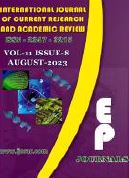Abstract Volume:11 Issue-8 Year-2023 Original Research Articles
 |
Online ISSN : 2347 - 3215 Issues : 12 per year Publisher : Excellent Publishers Email : editorijcret@gmail.com |
Wheat production is expected to increase despite increased global food demand due to the influence of population growth and climate change. Providing enough safe and ensuring sustainable wheat production for a rapidly growing world population poses many challenges. Among the most serious hazardous, Fusarium head blight (FHB) caused by fungi of the genus, is one of the most dangerous and catastrophic wheat diseases. It has a wide geographic distribution and causes severe economic losses in wheat production worldwide. Several investigations noted that FHB epidemics were becoming widespread. An increasing frequency of FHB epidemics in wheat has resulted in significant yield reductions, and it is crucial to emphasize the future challenge of safeguarding wheat production under upcoming imminent climate change affecting environmental conditions. Climate change aggravates FHB epidemics by increasing wheat stresses and expanding the natural ranges for Fusarium species. Multiple outbreaks of FHB have affected Ethiopian wheat producers over the last few years, most notably in the 2022 cropping season. The infection leads to mycotoxin accumulation in grains, jeopardizing its suitability for human and animal consumption. Moreover, due to the toxicity of Fusarium mycotoxins and the impact of FHB on wheat production, prevention and control practices such as cultural practices, resistant cultivars and fungicide application must be integrated into the management strategy. Nowadays, there is an urgent need to make wheat production more robust and sustainable while still continuing to develop high-yielding, disease-resistant and climate-smart wheat varieties. This review aims to provide an overview of pathogen biology, current status, detection method and integrated management strategies. Generally, to safeguard wheat production and productivity from the deadliest FHB, we must struggle and fight by all means open to science.
How to cite this article:
Gizachew Hirpa Regasa. 2023. Harnessing and Sounding the Alarm on Fusarium Head Blight of Wheat: Current Status, Biology, Detection and Diagnosis Method, Mycotoxins and Integrated Management Options.Int.J.Curr.Res.Aca.Rev. 11(8): 35-52doi: https://doi.org/10.20546/ijcrar.2023.1108.005



Quick Navigation
- Print Article
- Full Text PDF
- How to Cite this Article
- on Google
- on Google Scholor
- Citation Alert By Google Scholar
